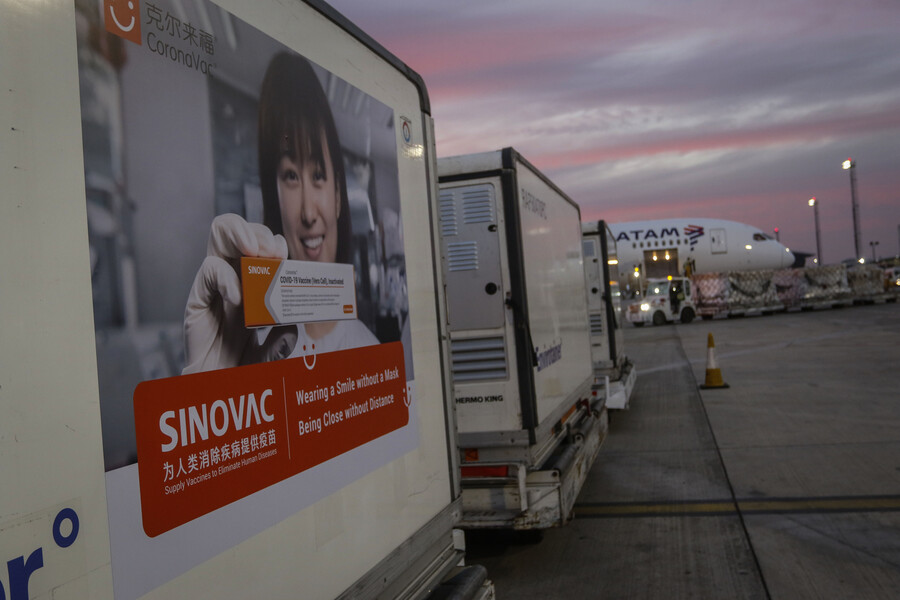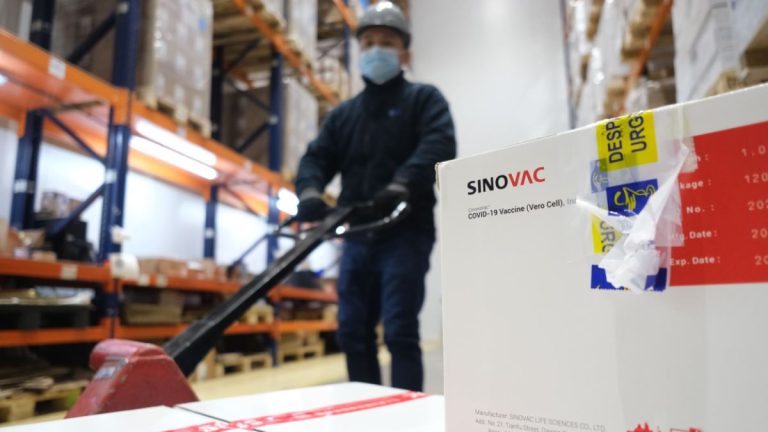RIO DE JANEIRO, BRAZIL – Sinovac’s landing in Chile began in the middle of last year. The Chinese company has already hired more than 20 people preparing the details for the business development. It is the biggest bet of the Asian laboratory in Latin America.
The arrival on Chilean soil is leveraged with developing a vaccine production plant. And everything is already prepared. It will be located in Quilicura and will start operating at the end of 2022. In the next two weeks, a delegation of 15 Chinese executives will arrive in Santiago to analyze the progress of the construction.
The plant will produce up to 50 million vaccines, including those against coronavirus, hepatitis, and influenza. Later, two more immunizations will be added: varicella and polio. They have already purchased the machinery and are waiting for it to be imported from China.

For the construction of the plant, the Chinese laboratory will disburse US$100 million. “There are different profiles that we are looking for: laboratory technicians, engineers, biochemists, and pharmacists,” says Virginia Garretón, vice-president of Corporate Affairs of Sinovac Biotech Chile and one of the main executives in the national operation.
She previously held the position of chief advisor to the Undersecretary of Science. She arrived on December 1 to lead the local subsidiary. Garretón, who has a Ph.D. in Cellular and Molecular Biology, says she starts her workday at 6 AM to coordinate with China and finishes at 10 PM, to coincide with the start of the Asian workday.
The general manager, Deyu Jiang, a specialist in vaccine production, oversees everything from the Chinese laboratory’s headquarters.
THE SITE
It all started in June 2021 when the Engel & Völkers office received a call from the Department of Molecular Genetics and Microbiology at the Catholic University (PUC). The request was as follows: Sinovac wanted to set up in Chile, and they needed a suitable location to set up a vaccine production plant.
The search was led by Felipe Weil, an executive of Engel & Völkers Commercial, the German brokerage company’s department dedicated to selling industrial, commercial, and office real estate. “We presented them with options, and this was the one they liked the most. They visited about ten different sites before deciding,” says Weil, who adds that they completed the transaction in “record time”. By November, everything was already signed.
The site is located in the industrial center of Quilicura and is currently unused. However, they chose it because it was built in 2010 with high safety standards, which will allow them to remodel and build on the site itself. In addition, they point out, it is very close to the airport and has connections to essential services.

The acquisition of the plant cost US$8 million, and now the plan is to remodel the site. It is a 12,000 square meter building with offices and an esplanade, which will be used for production. It will house more than 100 workers.
In addition, they are in the middle of a bidding process with different construction companies. The idea is to choose companies to take charge of the plant design (which will replicate the plans of Sinovac’s factories in China), remodeling, and sanitary technology. For each service, they will choose a different firm. They are racing against the clock, but Garretón says they are moving fast.
For now, the space will be “fill and finish” only, meaning that the vaccine liquid will come from China and be bottled in Chile. “Vaccine plants start like this in general because the primary part requires a lot of regulatory and professional capabilities. But the field can expand to primary production. The perspective is to transform the whole chain in the future,” says the VP of Corporate Affairs of Sinovac Biotech Chile.
THE NEGOTIATIONS
The plant seller was Opp Film, a plastics company belonging to a Peruvian holding company (Oben Group). Sinovac was represented by Carey, while the counterpart was with Philippi Prietocarrizosa Ferrero DU & Uría (PPU). “They were tough negotiations, many interlocutors. There was the language complexity to coordinate, plus it was all remote,” Weil recalls.
Sinovac’s original and primary partner in Chile is the Catholic University (PUC). Alexis Kalergis and Pablo González of the Millennium Institute in Immunology and Immunotherapy and Tomás Rivero are in charge of the technological scaling up of Dr. Kalergis’ team. In addition, this initiative had the support of the PUC management, headed by Ignacio Sanchez, physician and rector of the PUC.
“With Sinovac, there has been a scientific collaboration for vaccine research since before the pandemic. The interest in setting up in our country resulted from that positive collaboration,” says Alexis Kalergis. And he adds: “We supported Sinovac in connecting with the national public and private sector to move forward with its plant installation project. To this end, we visited several plots of land in different municipalities in the Metropolitan Region and other regions to evaluate locations where this facility could be set up. Sinovac’s first decisions were Quiilicura in the Región Metropolitana de Santiago (RM) and Antofagasta, which are now being evaluated in more detail by Sinovac for the next stages of implementation. In addition, at PUC, we have already implemented a vaccine research and development space in collaboration with Sinovac. PUC’s involvement is limited to scientific matters, without any commercial involvement”.
Last November, at the PUC Anacleto Angelini Innovation Center, Sinovac and the Catholic University formalized their relationship by signing a collaboration agreement. Sinovac’s CEO, Qiang Gao, participated in the event. On the same trip, they took the opportunity to sign the purchase and sale papers for the property.
The relationship between the Chinese laboratory and the PUC is so close that some members of the Sinovac Chile team occupy offices in the university’s Innovation Center.
Another key player was InvestChile, an organization led by Andrés Rodríguez and in charge of promoting foreign investment. The prominent representatives of this entity, among them Rodríguez himself and Cristián Sagal (Investment Promotion executive), held several meetings with Sinovac and PUC employees to coordinate the details of the landing of the laboratory. They also advised them on procedures with the Public Health Institute (ISP), visas, and internal regulations.
In addition, Sinovac executives frequently travel to Chile. Two weeks ago, the laboratory’s financial director was there to monitor the project’s progress.
ANTOFAGASTA CENTER IN DOUBT
The vaccine production plant is Sinovac’s short-term goal. “We have an important research and development plan, as it is not just about producing vaccines. We have to convince governments that vaccinations are safe”, says Garretón, who adds that they will also create a diploma and master’s degree program: “We are talking to different universities to train people interested in knowing how vaccines are produced, monitored, and marketed”.
In addition, one of Sinovac’s objectives is to produce vaccines with the variants produced in the southern hemisphere, since, for example, vaccinations against influenza use strains from the north. “The idea is to generate drugs with regional pathogens,” says Garretón.
Although in 2021 it was reported that Sinovac had a plot of land ready in Antofagasta to build a research and development center, Garretón says that nothing has been confirmed yet. He says that “the site does not have the right characteristics to be a research center because it does not have the permits or basic services. In addition, a train passes nearby that could interfere with precision studies”.
However, the idea is to continue sounding out places in Antofagasta to install a research hub: “We are very interested in that region because a group is working very well in clinical trials. We have to do something there,” he says.

